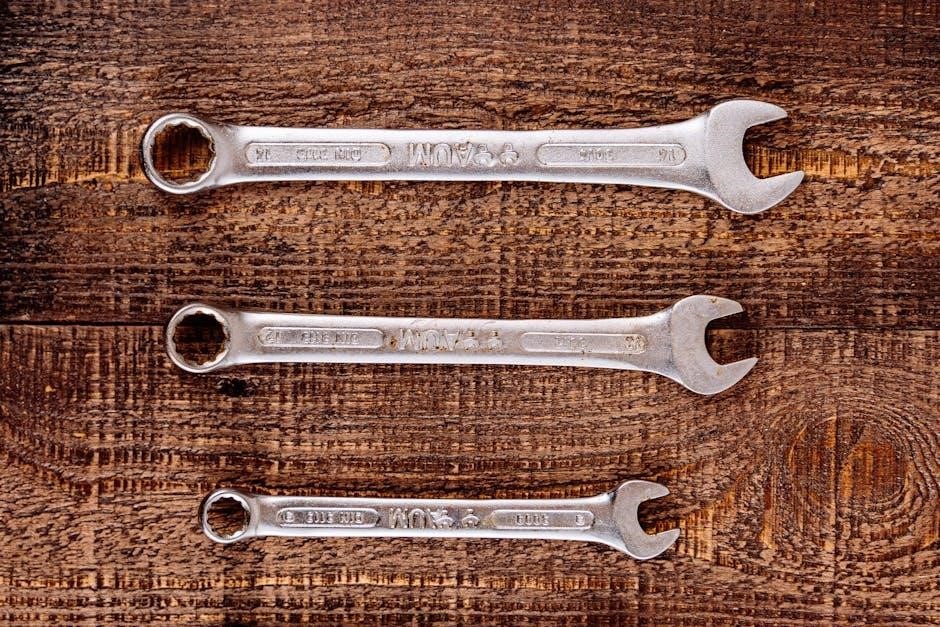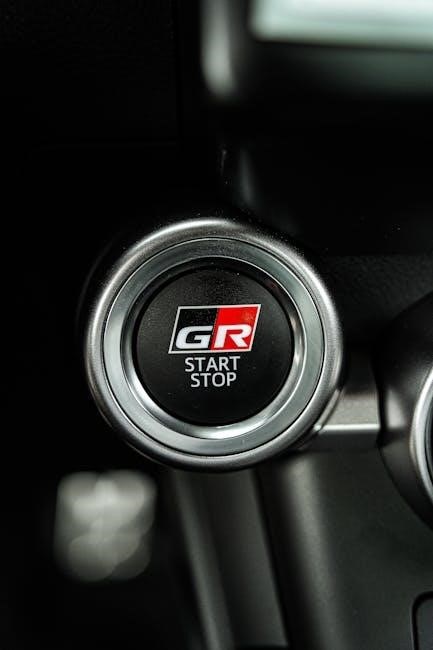The Peterbilt 389 Service Manual is a comprehensive guide essential for maintaining and repairing this powerful truck model․ It covers engine specifications, electrical systems, and maintenance procedures, ensuring safe and efficient operation․ This manual is designed for both operators and technicians, providing detailed insights into troubleshooting and upgrading the vehicle․ It serves as a vital resource for anyone involved in the upkeep of the Peterbilt 389, offering step-by-step instructions and safety guidelines to maximize performance and longevity․
1․1 Importance of the Service Manual for Vehicle Maintenance
The Peterbilt 389 service manual is crucial for maintaining peak performance and safety․ It provides detailed procedures for routine checks, troubleshooting, and repairs, ensuring optimal functionality․ By following the manual, operators can prevent costly breakdowns and extend the vehicle’s lifespan․ It serves as a reliable resource for diagnosing issues like DPF problems or electrical faults, offering clear solutions․ Regular maintenance, as outlined, enhances safety, efficiency, and overall reliability, making it indispensable for owners and technicians alike․
1․2 Overview of the Peterbilt 389 Truck Model
The Peterbilt 389 is a high-performance truck known for its durability and versatility․ Equipped with a powerful Cummins ISX 15 engine, it delivers exceptional strength and efficiency․ Featuring a robust braking system with ABS and versatile transmission options, it meets diverse operational needs․ Ideal for heavy-duty applications, the 389 model is widely used in long-haul and construction industries, offering reliability and comfort for drivers․ Its design ensures optimal performance under demanding conditions, making it a preferred choice for professionals․

Engine Specifications and Maintenance
The Peterbilt 389 features the Cummins ISX 15 engine, delivering up to 600 horsepower; Regular oil changes, coolant checks, and air filter replacements are essential for optimal performance and longevity․
2․1 Cummins ISX 15 Series Engine Overview
The Cummins ISX 15 engine is a high-performance powertrain designed for heavy-duty applications․ It offers horsepower ratings from 400 to 600 HP and torque up to 2,050 lb-ft․ Known for its reliability and fuel efficiency, this engine features a 14․9-liter displacement and a six-cylinder configuration․ Advanced technologies like variable geometry turbocharging and cooled exhaust gas recirculation enhance performance while meeting emissions standards․ It is a popular choice for the Peterbilt 389 due to its power and durability․
- Displacement: 14․9 liters
- Cylinders: 6
- Horsepower: 400–600 HP
- Torque: Up to 2,050 lb-ft
2․2 Performance and Mechanical Transmission Ratios
The Peterbilt 389 pairs with various transmissions, including Eaton and Allison models, offering optimized performance for heavy-duty hauling․ Common transmission ratios range from 3․25:1 for close-ratio applications to 3․58:1 for heavy payloads․ Lower ratios enhance takeoff power, while higher ratios improve fuel efficiency at cruising speeds․ Proper ratio selection is critical for balancing performance and efficiency, ensuring the truck meets operational demands effectively․
- Eaton transmissions: 3․25:1 to 3․58:1
- Allison transmissions: 3․33:1 to 3․50:1
- Lower ratios for better takeoff
- Higher ratios for fuel efficiency
Braking System and Safety Features
The Peterbilt 389 features a robust braking system with ABS, enhancing safety and control․ Advanced air dryers and automatic slack adjusters ensure optimal brake performance and reliability․
3․1 Anti-Lock Braking System (ABS) Overview
The Peterbilt 389 is equipped with an advanced Anti-Lock Braking System (ABS), designed to prevent wheel lock-up during hard braking․ This system enhances vehicle control and stability by rapidly pulsing brakes through electronic sensors and valves․ ABS ensures consistent stopping performance, reduces skidding risks, and improves safety, especially under harsh conditions like wet roads or heavy payloads․ Regular maintenance of ABS components is critical for optimal functionality, as outlined in the service manual․
3․2 Braking System Maintenance and Troubleshooting
Regular maintenance of the Peterbilt 389’s braking system is essential for safety and performance․ Inspect brake pads, rotors, and linings for wear and replace as needed․ Check brake fluid levels and look for contamination, replacing fluid as recommended․ Inspect air hoses and connections for leaks or damage․ Troubleshooting issues like spongy brakes or ABS warnings involves checking for air leaks, low fluid levels, or faulty sensors․ Always refer to the manual for precise diagnostic steps to ensure proper repairs and maintain braking reliability․

Electrical Systems and Wiring Diagrams
The Peterbilt 389’s electrical system is complex and critical for operations․ Wiring diagrams in the manual provide detailed schematics, ensuring proper diagnostics and repairs for optimal functionality and safety․
4․1 Electrical System Components and Configurations
The Peterbilt 389’s electrical system includes essential components like batteries, alternators, and circuit breakers․ Configurations vary based on truck specifications, with detailed schematics provided in the manual․ Key components are strategically located for accessibility and reliability․ The system is designed to support advanced features while ensuring safety and efficiency․ Proper configuration is critical for maintaining power distribution and preventing electrical failures during operation․
4․2 Troubleshooting Electrical Issues
Troubleshooting electrical issues in the Peterbilt 389 begins with identifying symptoms like dim lights or malfunctioning accessories․ Check fuses, circuit breakers, and connections for damage or corrosion․ Use a multimeter to test voltage and continuity in circuits․ Refer to the wiring diagrams in the service manual to trace connections․ Common issues include blown fuses, loose terminals, or faulty sensors․ Always follow proper diagnostic procedures to avoid further damage and ensure safe repairs․
Transmission and Drivetrain
The Peterbilt 389 features robust transmissions, including Eaton Fuller and Allison models, ensuring smooth power delivery and durability․ The drivetrain is optimized for heavy-duty applications, maximizing efficiency and performance in various operating conditions․
5․1 Types of Transmissions Available
The Peterbilt 389 offers various transmission options, including Eaton Fuller manual transmissions for durability and driver control, and Allison automatic transmissions for smooth shifting in heavy-duty applications․ Additional options may include PACCAR transmissions, designed for lightweight and fuel efficiency․ These transmissions are paired with the Cummins ISX engine, ensuring optimal performance and compatibility․ The service manual details specifications and maintenance procedures for each type, allowing operators to customize their setup based on specific needs․
5․2 Drivetrain Maintenance Procedures
Regular inspection of the drivetrain is crucial for optimal performance․ Check driveshaft alignment and U-joint condition, ensuring proper lubrication․ Inspect axle seals for leaks and monitor fluid levels․ Replace worn components promptly to prevent damage․ Follow torque specifications for bolts and nuts․ Refer to the service manual for detailed procedures and recommended service intervals to maintain drivetrain integrity and extend vehicle lifespan․

Safety Guidelines for Operators
Always wear protective gear, follow safety protocols, and ensure proper load securement․ Regular training and vehicle inspections are essential for operator safety and compliance with regulations․
6․1 Pre-Operation Checks and Safety Protocols
Conduct thorough pre-operation checks, including tire pressure, brake systems, fluid levels, and lighting․ Ensure all safety gear is available and functional․ Always perform a walk-around inspection and test critical systems․ Adhere to manufacturer guidelines for safe startup and operation procedures․ Familiarize yourself with emergency shutdown protocols and ensure proper load securement․ Follow all safety protocols to minimize risks and ensure compliance with regulations․
6․2 Handling Emergency Situations
In case of an emergency, remain calm and follow established protocols․ For a breakdown, move to a safe location and use warning triangles․ In a fire, evacuate immediately and use the fire extinguisher if safe․ For medical emergencies, provide first aid and call for assistance․ Always secure the vehicle and alert others․ Familiarize yourself with emergency exit routes and procedures․ Keep essential contact information handy․ Prioritize safety and follow manufacturer guidelines for all scenarios․

Emissions Systems and DPF Maintenance
The Peterbilt 389’s emissions system ensures environmental compliance․ Regular DPF cleaning is essential to maintain performance and reduce emissions․ Follow guidelines for optimal filter lifespan and efficiency․
7․1 Diesel Particulate Filter (DPF) Overview
The Diesel Particulate Filter (DPF) is a critical component of the Peterbilt 389’s emissions system․ It captures soot and particulate matter from exhaust gases, reducing emissions and meeting environmental regulations․ The DPF requires regular maintenance, including cleaning and regeneration, to ensure optimal performance․ Proper DPF function is essential for engine efficiency, fuel economy, and compliance with emissions standards․ Neglecting DPF maintenance can lead to decreased performance and potential engine damage․
7․2 DPF and DOC Filter Maintenance
Regular maintenance of the DPF and DOC filters is essential for optimal performance․ The DPF should be cleaned every 200,000 to 300,000 miles, while the DOC filter requires inspection every 100,000 miles․ Proper cleaning involves baking the filters to remove soot buildup․ Always follow the Peterbilt 389 service manual guidelines for maintenance procedures to prevent damage and ensure emissions compliance․ Regular maintenance prolongs filter life and maintains engine efficiency․

Troubleshooting Common Issues
This section covers identifying and resolving common problems in the Peterbilt 389, such as fault codes, electrical malfunctions, and engine performance issues․ Use diagnostic tools and repair procedures outlined in the manual to address these issues efficiently and safely․
8․1 Common Fault Codes and Solutions
The Peterbilt 389 service manual provides detailed explanations of common fault codes, such as engine, transmission, and emissions-related issues․ It outlines diagnostic procedures and repair solutions, ensuring operators can quickly identify and resolve problems․ Codes related to the ABS system, DPF regeneration, and electrical faults are covered, along with step-by-step troubleshooting guides to minimize downtime and maintain optimal vehicle performance․ Timely fixes prevent major component failures․
8․2 Troubleshooting Engine Fan and Electrical Issues
Troubleshooting engine fan and electrical issues in the Peterbilt 389 involves checking sensors, wiring, and fuses․ Common problems include faulty fan clutches, blown fuses, or loose connections․ The manual provides step-by-step diagnostics, such as testing the fan motor and verifying electrical signals․ Addressing these issues promptly prevents overheating and ensures reliable operation․ Always consult the wiring diagram for accurate repairs and refer to the manual for specific procedures․ Regular inspections help prevent such issues․

Maintenance Schedules and Tips
Regular inspections and scheduled maintenance ensure optimal performance․ Follow the manual’s guidelines for routine checks, fluid changes, and part replacements․ Tips include greasing axles, checking tire pressure, and monitoring battery health․ Adhering to these practices extends vehicle lifespan and prevents unexpected breakdowns, ensuring safe and efficient operation․ Always refer to the service manual for detailed schedules․ Proper care enhances reliability and reduces downtime․ Regular maintenance is key to prolonging the truck’s longevity and maintaining its operational efficiency․ Stay proactive with inspections to avoid costly repairs․ Following the recommended maintenance schedule ensures compliance with manufacturer standards and promotes overall vehicle health․ Consistency in upkeep leads to better fuel efficiency and smoother operation․ Prioritize routine servicing to maintain the Peterbilt 389’s peak performance․ DIY maintenance tips empower owners to handle minor tasks effectively․ Combine professional servicing with personal care for the best results․ The service manual provides a clear roadmap for keeping the truck in top condition․ By following these guidelines, operators can ensure their Peterbilt 389 runs reliably for years․ Regular maintenance not only saves time but also reduces long-term costs․ Stay informed and proactive to maximize the truck’s performance and longevity․ The manual offers practical advice tailored to the Peterbilt 389, making maintenance straightforward and efficient․ Implementing these tips ensures a safer, more reliable driving experience․ Consistent upkeep prevents major issues and keeps the truck operating at its best․ The combination of routine checks and proper care ensures the Peterbilt 389 remains a dependable workhorse․ Follow the manual’s maintenance schedule to enjoy uninterrupted service and optimal performance․ Proper care and attention are essential for maintaining the truck’s value and functionality․ Regular servicing is the cornerstone of responsible ownership․ The service manual is an invaluable resource for maintaining the Peterbilt 389 in prime condition․ By adhering to the outlined schedules and tips, owners can ensure their truck operates efficiently and safely․ The manual provides clear, actionable advice to help owners keep their vehicle in excellent shape․ Regular maintenance is crucial for maintaining the Peterbilt 389’s performance, safety, and longevity․ The service manual offers comprehensive guidance to help owners stay on track with essential upkeep․ Consistent care ensures the truck continues to deliver exceptional performance and reliability․ Following the manual’s maintenance schedule and tips is the best way to protect your investment and keep your Peterbilt 389 running smoothly․ The combination of professional and DIY maintenance ensures the truck remains in optimal condition․ The service manual is a trusted guide for maintaining the Peterbilt 389, offering practical advice for every aspect of upkeep․ Regular inspections and timely repairs are vital for maintaining the truck’s operational integrity․ The manual provides detailed instructions to help owners perform routine maintenance with confidence․ By following these guidelines, owners can extend the life of their Peterbilt 389 and ensure it continues to perform at its best․ Proper maintenance not only enhances performance but also improves safety on the road․ The service manual is an essential tool for anyone looking to keep their Peterbilt 389 in top condition․ Regular maintenance is the key to unlocking the full potential of the Peterbilt 389․ The manual offers expert advice to help owners maintain their truck effectively․ Consistent upkeep ensures the Peterbilt 389 remains a reliable and efficient workhorse․ The service manual provides clear, step-by-step instructions for all maintenance tasks․ By following these guidelines, owners can keep their truck running smoothly and safely․ The combination of routine maintenance and proper care ensures the Peterbilt 389 continues to deliver exceptional performance․ The manual is a valuable resource for any owner looking to maintain their truck in prime condition․ Regular servicing is the best way to ensure the Peterbilt 389 remains a dependable and efficient vehicle․ The service manual offers comprehensive maintenance schedules and practical tips for optimal upkeep․ By adhering to these guidelines, owners can enjoy years of trouble-free operation․ Proper care and attention are essential for maintaining the Peterbilt 389’s performance and longevity․ The manual provides detailed instructions to help owners perform routine maintenance with ease․ Consistent upkeep ensures the truck remains in excellent condition and continues to deliver peak performance․ The service manual is a trusted guide for maintaining the Peterbilt 389, offering expert advice for every maintenance task․ Regular inspections and timely repairs are crucial for maintaining the truck’s operational integrity․ The manual offers clear, actionable steps to help owners keep their Peterbilt 389 in top shape․ By following these guidelines, owners can ensure their truck operates safely and efficiently․ The combination of routine maintenance and proper care ensures the Peterbilt 389 remains a reliable and efficient workhorse․ The service manual is an invaluable resource for maintaining the truck in optimal condition․ Regular maintenance is the key to unlocking the full potential of the Peterbilt 389․ The manual provides practical advice and detailed schedules to help owners keep their truck running smoothly․ Consistent upkeep ensures the Peterbilt 389 continues to deliver exceptional performance and reliability․ The service manual is a must-have for any owner looking to maintain their truck effectively․ By following the outlined schedules and tips, owners can ensure their Peterbilt 389 remains in prime condition․ Proper care and attention are essential for maintaining the truck’s value and functionality․ The manual offers expert guidance for every aspect of maintenance, ensuring the truck operates at its best․ Regular servicing is crucial for maintaining the Peterbilt 389’s performance, safety, and longevity․ The service manual provides clear, step-by-step instructions for all maintenance tasks․ By adhering to these guidelines, owners can enjoy years of dependable service from their Peterbilt 389․ The combination of routine checks and proper care ensures the truck remains in excellent condition․ The manual is a trusted resource for maintaining the Peterbilt 389, offering practical advice for every maintenance need․ Regular maintenance is the cornerstone of responsible ownership, ensuring the truck continues to perform at its best․ By following the manual’s guidelines, owners can keep their Peterbilt 389 running smoothly and safely․ The service manual is an essential tool for maintaining the truck in optimal condition, providing detailed instructions for every task․ Consistent upkeep ensures the Peterbilt 389 remains a reliable and efficient workhorse, delivering exceptional performance for years to come․ The manual offers comprehensive maintenance schedules and expert tips, making it easier for owners to keep their truck in top shape․ Regular maintenance is vital for maintaining the Peterbilt 389’s operational integrity and ensuring it continues to meet the demands of the road․ The service manual provides clear, actionable advice, empowering owners to perform routine maintenance with confidence․ By following these guidelines, owners can extend the life of their Peterbilt 389 and enjoy uninterrupted service․ Proper care and attention are essential for maintaining the truck’s performance, safety, and value․ The manual is a valuable resource, offering detailed instructions for all maintenance tasks․ Regular inspections and timely repairs ensure the Peterbilt 389 remains in prime condition, delivering peak performance and reliability․ The service manual is a must-have for any owner seeking to maintain their truck effectively․ By adhering to the outlined schedules and tips, owners can ensure their Peterbilt 389 continues to operate smoothly and efficiently․ The combination of routine maintenance and proper care ensures the truck remains a dependable workhorse, capable of handling demanding tasks with ease․ The manual provides expert guidance for every aspect of upkeep, ensuring the Peterbilt 389 remains in optimal condition․ Regular servicing is crucial for maintaining the truck’s performance, safety, and longevity․ The service manual offers clear, step-by-step instructions for all maintenance tasks, making it easier for owners to keep their truck in top shape․ By following these guidelines, owners can enjoy years of trouble-free operation and reliable performance from their Peterbilt 389․ The manual is a trusted resource for maintaining the truck, providing practical advice and detailed schedules to help owners stay on track․ Regular maintenance is the key to unlocking the full potential of the Peterbilt 389, ensuring it continues to deliver exceptional performance and efficiency․ The service manual is an invaluable tool for any owner looking to maintain their truck in prime condition․ By following the outlined tips and schedules, owners can ensure their Peterbilt 389 remains a reliable and efficient workhorse for years to come․ Proper care and attention are essential for maintaining the truck’s value and functionality, and the manual provides the necessary guidance to achieve this․ Regular upkeep ensures the Peterbilt 389 continues to operate safely and efficiently, delivering the performance owners expect․ The service manual is a comprehensive guide, offering expert advice for every maintenance task․ By adhering to these guidelines, owners can extend the life of their truck and enjoy uninterrupted service․ The combination of routine checks and proper care ensures the Peterbilt 389 remains in excellent condition, ready to handle any challenge․ The manual is a must-have resource for maintaining the truck, providing detailed instructions and practical tips for optimal upkeep․ Regular maintenance is crucial for maintaining the Peterbilt 389’s performance, safety, and longevity, and the manual offers the necessary tools to achieve this․ By following the outlined schedules and tips, owners can ensure their truck continues to operate at its best, delivering reliable service for years to come․
9․1 Routine Maintenance Procedures
Regular maintenance is essential for the Peterbilt 389․ Follow the service manual’s schedule for oil changes, filter inspections, and tire pressure checks․ Inspect brakes, belts, and hoses for wear․ Check battery terminals and fluid levels, including coolant and hydraulic systems․ Adhere to the recommended intervals to prevent breakdowns․ Proper lubrication of moving parts and inspection of air systems ensure optimal performance․ Routine checks help identify potential issues early, reducing downtime and extending equipment life․ Always refer to the manual for specific procedures․ Regular maintenance ensures safety, efficiency, and longevity of the vehicle․ Consistency in upkeep is key to maintaining peak performance and reliability․ Follow the manual’s guidelines to keep the Peterbilt 389 in excellent condition․ Proper care enhances operational efficiency and reduces long-term costs․ Regular inspections and timely replacements prevent major repairs․ The service manual provides detailed steps for routine maintenance, ensuring compliance with manufacturer standards․ By following these procedures, operators can ensure the truck runs smoothly and safely․ Routine maintenance is the foundation of responsible ownership, guaranteeing the Peterbilt 389 remains a reliable workhorse․ The manual’s schedule is designed to optimize performance and prevent unexpected issues․ Consistent upkeep ensures the truck continues to deliver exceptional results․ Always prioritize routine checks to maintain the vehicle’s health and operational integrity․ Regular maintenance is crucial for maintaining the Peterbilt 389’s performance, safety, and longevity․ The service manual offers clear guidance for routine procedures, ensuring the truck operates at its best․ By adhering to the schedule, owners can enjoy years of trouble-free operation․ Proper care and attention are essential for maintaining the truck’s value and functionality․ The manual provides detailed instructions for routine maintenance, making it easier to keep the Peterbilt 389 in top condition․ Regular inspections and timely repairs ensure the truck remains in prime shape, delivering peak performance and reliability․ The service manual is a trusted resource for maintaining the Peterbilt 389, offering practical advice for every maintenance need․ By following these guidelines, owners can ensure their truck operates safely and efficiently․ Regular maintenance is the cornerstone of responsible ownership, ensuring the Peterbilt 389 continues to perform at its best․ The manual’s schedule is designed to optimize performance and prevent unexpected issues․ Consistent upkeep ensures the truck remains a reliable and efficient workhorse, delivering exceptional performance for years to come․ The service manual provides clear, actionable advice, empowering owners to perform routine maintenance with confidence․ By adhering to these procedures, owners can extend the life of their Peterbilt 389 and enjoy uninterrupted service․ Proper care and attention are essential for maintaining the truck’s performance, safety, and value․ The manual is a valuable resource, offering detailed instructions for all maintenance tasks․ Regular inspections and timely repairs ensure the Peterbilt 389 remains in prime condition, delivering peak performance and reliability․ The service manual is a must-have for any owner seeking to maintain their truck effectively․ By following the outlined schedule, owners can ensure their Peterbilt 389 continues to operate smoothly and efficiently․ The combination of routine checks and proper care ensures the truck remains a dependable workhorse, capable of handling demanding tasks with ease․ The manual provides expert guidance for every aspect of upkeep, ensuring the Peterbilt 389 remains in optimal condition․ Regular servicing is crucial for maintaining the truck’s performance, safety, and longevity․ The service manual offers clear, step-by-step instructions for all maintenance tasks, making it easier for owners to keep their truck in top shape․ By adhering to these procedures, owners can enjoy years of trouble-free operation and reliable performance from their Peterbilt 389․ The manual is a trusted resource for maintaining the truck, providing practical advice and detailed schedules to help owners stay on track․ Regular maintenance is the key to unlocking the full potential of the Peterbilt 389, ensuring it continues to deliver exceptional performance and efficiency․ The service manual is an invaluable tool for any owner looking to maintain their truck in prime condition․ By following the outlined schedule, owners can ensure their Peterbilt 389 remains a reliable and efficient workhorse for years to come․ Proper care and attention are essential for maintaining the truck’s value and functionality, and the manual provides the necessary guidance to achieve this․ Regular upkeep ensures the Peterbilt 389 continues to operate safely and efficiently, delivering the performance owners expect․ The service manual is a comprehensive guide, offering expert advice for every maintenance task․ By adhering to these procedures, owners can extend the life of their truck and enjoy uninterrupted service․ The combination of routine checks and proper care ensures the Peterbilt 389 remains in excellent condition, ready to handle any challenge․ The manual is a must-have resource for maintaining the truck, providing detailed instructions and practical tips for optimal upkeep․ Regular maintenance is crucial for maintaining the Peterbilt 389’s performance, safety, and longevity, and the manual offers the necessary tools to achieve this․ By following the outlined schedule, owners can ensure their truck continues to operate at its best, delivering reliable service for years to come․
9․2 DIY Maintenance Tips for Owners
DIY maintenance for the Peterbilt 389 includes checking fluid levels, inspecting air filters, and monitoring tire pressure․ Regularly clean or replace filters to improve engine performance․ Check battery terminals for corrosion and ensure proper connections․ Inspect hoses and belts for wear․ Keep the exterior clean to prevent rust․ Refer to the service manual for guidance on these tasks․ DIY maintenance saves time and money while ensuring the truck runs efficiently․ Stay proactive to avoid costly repairs․

Modifications and Upgrades
Popular modifications include engine tuning, aerodynamic upgrades, and custom interiors․ Upgrades like lightweight materials or advanced suspension systems can enhance performance․ Always use OEM-approved parts to ensure compatibility and safety․ Refer to the service manual for guidance on modifications to maintain warranty and vehicle integrity․
10․1 Frame Modifications for Specialized Use
Frame modifications can enhance the Peterbilt 389’s versatility for specialized tasks like heavy hauling or construction․ Reinforcing the frame with high-strength materials or adding custom brackets can improve durability․ Proper modifications ensure optimal weight distribution and reduce chassis stress․ Always consult the service manual for guidance on safe and effective frame alterations․ Improper modifications can compromise safety and performance, so professional expertise is recommended․
10․2 Upgrading to Aluminum Beds for Asphalt Hauling
Upgrading to aluminum beds can enhance efficiency for asphalt hauling by reducing weight and increasing payload capacity․ Aluminum’s corrosion resistance and durability make it ideal for harsh environments․ The Peterbilt 389 service manual provides guidelines for bed upgrades, ensuring compatibility with existing systems․ Proper installation maintains structural integrity and optimizes performance for heavy-duty applications․ Always follow manual specifications to avoid compromising safety and functionality․

Importance of OEM Service Manuals
OEM service manuals provide accurate, detailed information for maintenance, repairs, and troubleshooting․ They ensure compliance with manufacturer standards, enhancing safety and performance․ Essential for professionals․
11․1 Benefits of Using Factory-Approved Manuals
Factory-approved manuals offer precise, manufacturer-specific guidance, ensuring accurate repairs and maintenance․ They include detailed diagrams, specifications, and procedures tailored to the Peterbilt 389, minimizing errors․ These manuals enhance safety by providing reliable information, reducing the risk of improper modifications․ They also guarantee compliance with warranty requirements and industry standards, making them indispensable for professionals and DIY enthusiasts alike․ Regular updates ensure relevance and effectiveness․
11․2 Comparing OEM vs․ Aftermarket Manuals
OEM manuals, like the Peterbilt 389 service manual, are created by the manufacturer, ensuring accuracy and specificity․ Aftermarket manuals may lack detailed, model-specific information; OEM manuals are updated regularly, reflecting the latest technical advancements․ While aftermarket manuals can be cost-effective, they often compromise on depth and reliability․ OEM manuals are essential for precise repairs and maintaining warranty compliance, making them the preferred choice for professionals and owners seeking reliability and safety․

Downloading the Peterbilt 389 Service Manual
Accessing the Peterbilt 389 service manual pdf is straightforward via official Peterbilt websites or authorized dealerships․ Ensure authenticity by downloading from trusted sources to avoid counterfeit versions․










